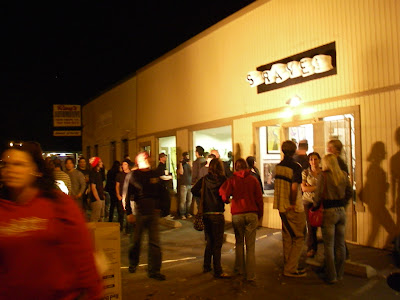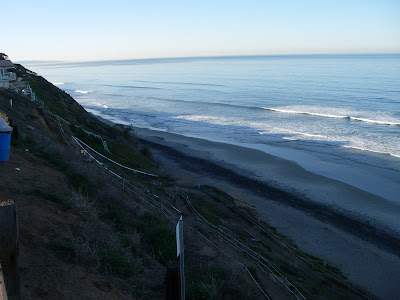click image for large view ON THE WATER: SURFINGSurfers willfully have head in the sand
ON THE WATER: SURFINGSurfers willfully have head in the sandBy Brad Melekian
March 27, 2007
In many ways, being a surfer means being a naturalist.
This can seem like a silly thing to write in a place like San Diego, where most waves break within sight and sound of highways and apartment buildings, shopping centers and urban development.
But who else except for surfers would notice, for instance, the growth and development of an offshore kelp bed? What other “user group” can look at a patch of impenetrable dark water and tell an observer the exact shape of the reef that lies beneath? Or the depth of the offshore canyon leading to the beach? Or the levels of sand on the beach today compared to three months ago, six months ago, two years ago? Who else (multimillion dollar property owners excluded) considers coastal bluff erosion a matter pertinent to their daily life?
Consider the daily agenda of the
tens of thousands of surfers in San Diego County, most of whom return morning and night to the same patch of ocean, monitoring either knowingly or through natural osmotic process the changes in the environment, and it's clear that, whether in ways subtle or pronounced, these people are indeed naturalists.
In this way, surfers tend to notice changes – the posting of building permits on a long-vacant beachfront lot, or the not-so-subtle rumble of bulldozers harkening the man-made addition of thousands of cubic yards of sand to a beach.
This latter example – the one involving the additional tonnage of sand – has been the subject of discussion lately as government officials and lobbying groups are considering a plan to spend north of $20 million to deposit sand on beaches from Oceanside to Imperial Beach.
Most surfers – particularly the older ones who have seen pockets of San Diego develop from sleepy beach burgs to metropolitan suburbs – are not surprised by such plans. As with previous projects for seawalls and jetties and parking lots, this latest sand initiative garners mainly a grimacing harrumph.
No matter their feelings on the topic, most surfers know something about sand. It can create waves and ruin waves, depending. Reef breaks covered in sand won't work as well as they might, and sandbars require the depositing of sand to function at their best. But more than anything, surfers know that sand is malleable.In 2001, the San Diego Association of Governments spent $16.5 million to deposit sand on county beaches. They might have consulted surfers on this project, because any 15-year-old could have told them between his top turns that it would take precisely one strong wintertime northwest swell to rid the beaches of all that fresh white new sand (which is more or less what happened).
You see, one doesn't spend hours and days and years and decades of one's life looking at the same patch of wild ocean without learning from it. Namely, surfers have learned that everything, at least in nature, happens cyclically. And though many, if not most surfers, try to keep their daily sessions in the realm of the personal and not the political, it's hard not to feel affected by something as seemingly innocuous as sand on the beach when you're the one fronting that beach every day.
Surfers are nothing if not a migratory herd, willing to follow wind, tide, swell and, yes, sandbars wherever they might pop up, and through many changes. But as coastal development, seawalls, offshore construction and even sand replenishment continues to put the pinch on surfers, surfers are becoming less and less surprised when big bulldozers trumpet the arrival of the latest beach improvement – whether a sandbar, a parking lot or a seawall.
Like all good naturalists, they see it, register it and move on to the next wave.
Brad Melekian can be reached by e-mailing him at sports@uniontrib.com
Leucadia!: Kids have fun at beach despite cobblestone boogeyman



























